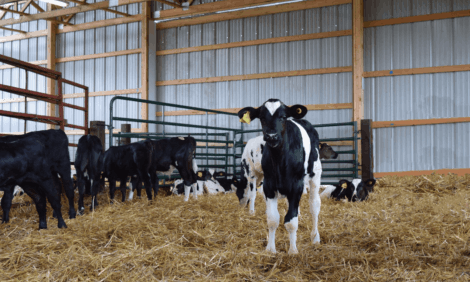



A Recipe For Healthy Calves
Professor Bob James of Virginia State University emphasises that getting calves off to a good start hinges on a successful colostrum programme and cleanliness.Ask nearly any calf care giver and they can recite the colostrum mantra, says Dairy Nutritionist Prof James.
Feed high quality colostrum. Levels exceeding 50g of IgG/liter are considered good quality. The Brix refractometer provides a quick method for testing colostrum on the farm. Values exceeding 22 indicate good quality.
- Feed enough colostrum and feed it early in life. It is commonly recommended that the calf receive 4 liters/ quarts in the first 12 hours after birth.
- This provides approximately 200 g of IgG which is more than adequate.
- The final step may be the most important and that is to CLEAN!
*
"The problem on many farms is that calves are born into less than desirable conditions."
Consider that it is a race between colostrum antibodies (IgG) and bacteria reaching the site of absorption in the small intestine. If bacteria win the race then antibody absorption is likely to be severely reduced regardless of the amount of antibody that the calf consumes. Excessive bacteria can arise from two sources.
The first is the calving environment and the second one is poorly handled colostrum. If the first exposure of the calf after being born is a mouthful of manure from a poorly bedded box stall, bacterial growth in the small intestine can number in the millions within a few hours of birth.
As it comes from the cow, first milking colostrum has a relatively low bacteria count (<100 cfu/ml). However Minnesota researchers found that, on the average, the colostrum bacteria counts obtained from either an esophageal feeder or a floor bucket exceeded 10,000 cfu/ml.
It was interesting that their study found excessive variation in counts observed from farm to farm.
Bacterial counts from colostrum on some farms exceeded 100,000,000 cfu/ml. Why the large differences?
Although they didn’t study colostrum handling procedures there are several likely causes. The first being sanitation of the collection buckets and esophageal feeders. The second cause is storage of colostrum for more than a few hours at room temperature.
It is important that any container exposed to colostrum is cleaned as carefully as the milking equipment! After each use the container should be cleaned using the following steps in order:
- rinse with lukewarm water
- scrub with hot soapy water
- rinse with a sanitizer
- invert to allow drying
Rinsing with hot water causes biofilms to form on the container surface which are conducive to growing bacteria.
The importance of bacteria levels in colostrum was demonstrated most recently by a Minnesota field trial involving 1,000 calves on 6 farms.
One half of the calves were fed raw colostrum while the other half received pasteurized colostrum. They found that the high level of coliform bacteria in raw colostrum was highly negatively correlated with colostrum antibody absorption.
The problem on many farms is that calves are born into less than desirable conditions. In addition, failure to store colostrum in clean containers promotes excessive bacterial growth. Colostrum management should include strict adherence to cleaning protocols for any surface exposed to, or used to store or administer colostrum.
Clean containers prevent bacterial growth and make early feeding or prompt cooling of colostrum less critical to success.


